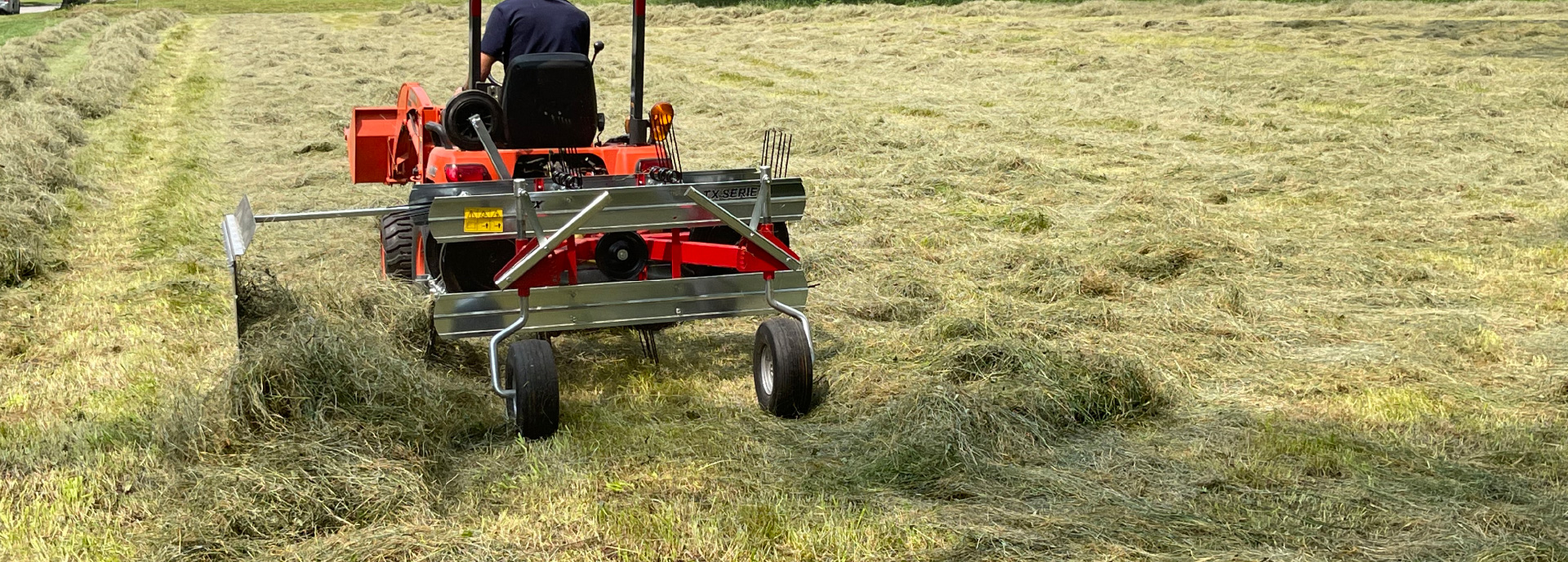The Belt Rake—An Exceptional Choice for Small-Farm Hay Production

Here at Tractor Tools Direct, our Ibex Belt Rake has become one of our very best sellers. At the same time, it is also a product with which most of our customers are unfamiliar until they find it on our website. For this reason, this month’s blog will answer the question: What is a belt rake, and why is it such an exceptional choice for small-farm hay production? Although belt rakes have been a standard choice for hay making in Europe for quite some time, they are now becoming quite popular in the United States. Belt rakes are a great solution for those who need a simple, durable, high quality machine for their raking needs. They require very little power to operate and come in many sizes making them perfect for the smallest of compact tractors on up.
A belt rake works by moving a series of tines perpendicular to the tractor’s direction of travel, just above the ground surface. The tines are mounted to two large belts that are driven by the tractor’s PTO. As they move through the hay stubble, they collect the hay and push it to one side of the machine, where it is thrown up against a haystop. This causes the hay to drop to the ground in a fluffy pile, or windrow. If use as a tedder rather than a rake is desired, the haystop can be removed.
“Because a belt rake fits directly behind the tractor and is compact, it can be used to rake in places that other conventional tractor-driven hay rakes can’t go. This makes them an excellent choice for haying on small farms where pastures and paddocks can be small, fenced in, and irregularly shaped.”
Their lighter weight also makes them safer to operate on steep slopes than conventional rakes. Furthermore, because a belt rake is so compact and operates directly behind the tractor, the operator spends less time turned around checking to see where his or her rake actually is.
A belt rake is powered by the tractor PTO, so it continues to run while stationary, or when backing up, allowing you to use the rake in reverse in tight spaces.It also does a better job around corners and will not pile up hay like a wheel rake when turning. Thus, you will end up with a straight, fluffy, consistent windrow that dries well and is easy to follow with a baler.

Belt rakes are easy to operate, even for beginners. Connection is simple, and once connected, raking height can be quickly adjusted with levers located on its pneumatic wheels.
Unlike most hay rakes, the width of the windrow is also adjustable, so it’s easy to match the size of your windrow to the size of your baler. Furthermore, their compactness and light weight make them easy for your tractor to lift, making transport and navigation an easy task.
A belt rake is also two implements in one. In only 30 seconds and without tools, a belt rake can be converted into a tedder to spread hay. This is accomplished with the simple removal of a hay stop located at the end of the belt. Because a belt rake can perform multiple jobs, it eliminates the need for other pieces of equipment, which saves space in the storage shed and money in the wallet.
A belt rake is also quite versatile. While it’s a superior hay rake, it also works well for raking leaves and pine straw. As a matter of fact, small belt rakes fit perfectly between the tree rows of pine plantations making them a popular tool in the pine straw baling industry. Compact belt rakes can also be used to maintain orchards and vineyards since they fit easily between the rows of vines or fruit trees.
Now you can see why belt rakes are such an exceptional choice for small-farm hay production.
They are compact, durable, versatile, and simple to use. If you would to learn more these rakes,please visit our website here. Or give our team a call at 260-BALE-HAY today!
Ibex TX80 Compact Belt Rake
Recent Posts
-
Best Front Loader Attachments for Your Kubota BX Series Tractor
If you own a Kubota BX-series compact tractor, you already know it’s a versatile machine — but p …Dec 30th 2025 -
Boost Pine Straw Production Efficiency with Ibex Mini Round Balers
At Tractor Tools Direct, we're known for our high-quality hay equipment tailored for small farms …Dec 8th 2025 -
How to Winterize Your Tractor: Essential Maintenance Tips to Protect Your Investment
Farm equipment is one of the most valuable investments a farmer can make. At Tractor Tools Direc …Dec 1st 2025




